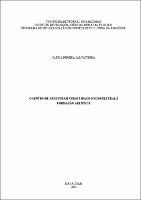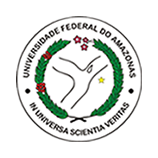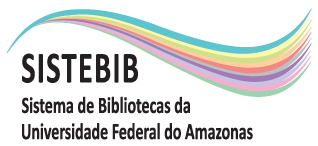| ???jsp.display-item.social.title??? |


|
Please use this identifier to cite or link to this item:
https://tede.ufam.edu.br/handle/tede/11006| ???metadata.dc.type???: | Dissertação |
| Title: | O Centro de Artes/UFAM como espaço sociocultural e formação artistica |
| ???metadata.dc.creator???: | Salvatierra, Clezia Pereira  |
| ???metadata.dc.contributor.advisor1???: | Barros, Rosemara Staub |
| ???metadata.dc.contributor.referee1???: | Furtado, Lucas Antunes |
| ???metadata.dc.contributor.referee2???: | Texeira, Caio Augusto |
| ???metadata.dc.description.resumo???: | Esta pesquisa, fundamentada na abordagem qualitativa, utilizando metodologia mista a historiografia e a metodologia da História Oral, tem como objetivo analisar o espaço sociocultural e a formação artística no Centro de Artes da Universidade Federal do Amazonas no período de 1990 a 2020. A investigação busca aprofundar as conjecturas, sociais, culturais e educacionais um espaço de resistência, desde sua origem como Conservatório de Música Joaquim Franco a sua atual nomeclatura um órgão suplementar Centro de Artes da Universidade Federal do Amazonas/CAUA, destacando as fases pelas quais passou e os processos de formação artística desenvolvidos ao longo das décadas. Em um contexto marcado por um momento culturalmente efervescente em Manaus, a pesquisa explora como o CAUA enfrentou desafios e qual foi sua contribuição para a sociedade manauara, tanto no campo educacional quanto no artístico e social. Para alcançar esses objetivos, foram realizadas entrevistas semiestruturadas, além de levantamentos documentais, coletas de dados em jornais e análise de acervos artísticos. Esses materiais permitiram reconstruir a história do espaço, que por muitos anos, ocupou posição central nas atividades artísticas e educativas de Manaus. Os aspectos levantados foram examinados sob a perspectiva teórica de autores como Bourdieu (2010), Thompson (1998), Delgado (2006), Alberti (1990 e 2005) e Meihy e Holanda (2015), que enfatizam a historiografia junto com a História Oral como metodologias de pesquisa ancorada em atividades sistemáticas de coleta e interpretação de dados. A pesquisa foi estruturada em três etapas principais: a primeira consistiu em conhecer a história do Centro de Artes, quando ainda era o Conservatório de Música Joaquim Franco, identificando os principais atores desse período; a segunda envolveu a análise de conteúdo proposta por Bardin, compreendendo as etapas de pré-análise, análise categorial, codificação e interpretação narrativa; e a terceira focou na apresentação dos resultados e conclusões. Essa abordagem permitiu uma compreensão profunda das memórias, experiências e significados atribuídos ao CAUA ao longo de sua existência. Os resultados desta pesquisa contribuem para o entendimento do papel do CAUA/UFAM como um espaço dedicado à formação artística e à construção social, valorizando os contextos históricos, culturais e sociais que moldaram sua trajetória. Além disso, destaca-se a relevância das entrevistas como ferramenta para resgatar memórias e construir a história de épocas, momentos e vivências que, muitas vezes, não foram registradas formalmente. Esse esforço de preservação é essencial para que não se perca a memória desse espaço histórico, garantindo seu um importante patrimônio cultural e educacional para a cidade de Manaus e para a Amazônia. |
| Abstract: | This research, based on a qualitative approach, using a mixed methodology of historiography and oral history methodology, aims to analyze the socio-cultural space and artistic training at the Arts Center of the Federal University of Amazonas from 1990 to 2020. The investigation seeks to delve into the social, cultural and educational conjectures of a space of resistance, from its origins as the Joaquim Franco Conservatory of Music to its current name as a supplementary body of the Arts Center of the Federal University of Amazonas/CAUA, highlighting the phases it went through and the artistic training processes developed over the decades. In a context marked by a culturally effervescent moment in Manaus, the research explores how CAUA faced challenges and what its contribution was to Manaus society, both in the educational and artistic and social fields. To achieve these objectives, semi-structured interviews were conducted, as well as documentary surveys, data collection from newspapers and analysis of artistic collections. These materials made it possible to reconstruct the history of the space, which for many years occupied a central position in Manaus' artistic and educational activities. The aspects raised were examined from the theoretical perspective of authors such as Bourdieu (2010), Thompson (1998), Delgado (2006), Alberti (1990 and 2005) and Meihy and Holanda (2015), who emphasize historiography together with Oral History as research methodologies anchored in systematic data collection and interpretation activities. The research was structured in three main stages: the first consisted of learning about the history of the Arts Center, when it was still the Joaquim Franco Conservatory of Music, identifying the main actors of that period; the second involved the content analysis proposed by Bardin, comprising the stages of pre-analysis, categorical analysis, coding and narrative interpretation; and the third focused on presenting the results and conclusions. This approach allowed for an in-depth understanding of the memories, experiences and meanings attributed to CAUA throughout its existence. The results of this research contribute to an understanding of the role of CAUA/UFAM as a space dedicated to artistic training and social construction, valuing the historical, cultural and social contexts that have shaped its trajectory. It also highlights the importance of interviews as a tool for recovering memories and building the history of times, moments and experiences that have often not been formally recorded. This preservation effort is essential if the memory of this historic space is not to be lost, guaranteeing its important cultural and educational heritage for the city of Manaus and the Amazon |
| Keywords: | Arte - Estudo e ensino Arte nas universidades e faculdades |
| ???metadata.dc.subject.cnpq???: | CIENCIAS HUMANAS: SOCIOLOGIA LINGUISTICA, LETRAS E ARTES: ARTES CIENCIAS HUMANAS: EDUCACAO |
| ???metadata.dc.subject.user???: | Centro de Artes Formação artística Relações Socioculturais História Oral |
| Language: | por |
| ???metadata.dc.publisher.country???: | Brasil |
| Publisher: | Universidade Federal do Amazonas |
| ???metadata.dc.publisher.initials???: | UFAM |
| ???metadata.dc.publisher.department???: | Instituto de Filosofia, Ciências Humanas e Sociais |
| ???metadata.dc.publisher.program???: | Programa de Pós-graduação em Sociedade e Cultura na Amazônia |
| Citation: | SALVATIERRA, Clezia Pereira. O Centro de Artes/UFAM como espaço sociocultural e formação artística. 2025. 222 f. Dissertação (Mestrado em Sociedade e Cultura na Amazônia) - Universidade Federal do Amazonas, Manaus (AM), 2025. |
| ???metadata.dc.rights???: | Acesso Aberto |
| ???metadata.dc.rights.uri???: | https://creativecommons.org/licenses/by-nc-nd/4.0/ |
| URI: | https://tede.ufam.edu.br/handle/tede/11006 |
| Issue Date: | 15-May-2025 |
| Appears in Collections: | Doutorado em Sociedade e Cultura na Amazônia |
Files in This Item:
| File | Description | Size | Format | |
|---|---|---|---|---|
| DISS_CleziaSalvatierra_PPGSCA.pdf | 5.4 MB | Adobe PDF |  Download/Open Preview |
Items in DSpace are protected by copyright, with all rights reserved, unless otherwise indicated.




